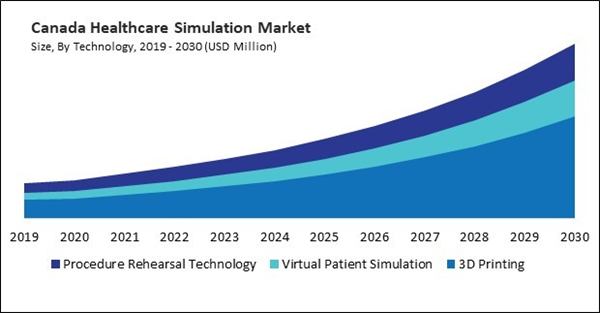The US market dominated the North America Healthcare Simulation Market by Country in 2022 and would continue to be a dominant market till 2030; thereby, achieving a market value of $1,749.6 million by 2030. The Canada market is experiencing a CAGR of 17.4% during (2023 - 2030). Additionally, The Mexico market would exhibit a CAGR of 16.4% during (2023 - 2030).
The market has become an attractive and quickly developing segment of the larger healthcare industry. It is driven by technological advancements, increasing demand for quality education and training, and the imperative to improve patient safety and outcomes. Simulation technology encompasses diverse tools and techniques to replicate real-world clinical scenarios and provide immersive, interactive learning experiences for healthcare professionals, students, and practitioners across various disciplines and specialties.
Rapid advancements in simulation technology have made simulation solutions more accessible, realistic, and user-friendly. From high-fidelity manikins and virtual reality (VR) simulators to web-based simulation platforms, a wide range of simulation tools and techniques are available to meet the diverse needs of healthcare educators and learners. Technological innovations such as haptic feedback, augmented reality (AR), and cloud-based simulation platforms have expanded the capabilities and applications of simulation technology, driving increased adoption across healthcare settings.
With increased investment in the healthcare sector, there is a greater emphasis on enhancing the skills and competency of healthcare professionals. The Canadian government states that as part of a $196.1 billion, ten-year investment to improve health care services for all Canadians, provinces and territories will get an additional $46.2 billion in funding in 2023. Hence, the increasing cancer cases and rising healthcare expenditure in the region drive the market’s growth.
Based on Technology, the market is segmented into Procedure Rehearsal Technology, Virtual Patient Simulation, and 3D Printing. Based on End-use, the market is segmented into Academic Institutes, Hospitals, Military Organizations and Research. Based on Product & Services, the market is segmented into Healthcare Anatomical Models (Patient Simulators {High Fidelity, Medium Fidelity and Low Fidelity}, Interventional/Surgical Simulators {Laparoscopic, Gynecology, Cardiovascular, Arthroscopic and Spine & Others}, Task Trainers, Endovascular Simulators, Ultrasound Simulators, Dental Simulators and Eye Simulators), Web-Based Simulators, Healthcare Simulation Software and Simulation Training Services. Based on countries, the market is segmented into U.S., Mexico, Canada, and Rest of North America.
List of Key Companies Profiled
- CAE Inc.
- Laerdal Medical Limited
- Gaumard Scientific Company, Inc.
- Kyoto Kagaku Co., Ltd.
- Limbs & Things Limited
- Mentice AB
- Simulab Corporation
- Intelligent Ultrasound Group PLC
- Surgical Science Sweden AB
- Medical-X
Market Report Segmentation
By Technology- Procedure Rehearsal Technology
- Virtual Patient Simulation
- 3D Printing
- Academic Institutes
- Hospitals
- Military Organizations
- Research
- Healthcare Anatomical Models
- Patient Simulators
- High Fidelity
- Medium Fidelity
- Low Fidelity
- Interventional/Surgical Simulators
- Laparoscopic
- Gynecology
- Cardiovascular
- Arthroscopic
- Spine & Others
- Task Trainers
- Endovascular Simulators
- Ultrasound Simulators
- Dental Simulators
- Eye Simulators
- Web-Based Simulators
- Healthcare Simulation Software
- Simulation Training Services
- US
- Canada
- Mexico
- Rest of North America
Table of Contents
Companies Mentioned
- CAE Inc.
- Laerdal Medical Limited
- Gaumard Scientific Company, Inc.
- Kyoto Kagaku Co., Ltd.
- Limbs & Things Limited
- Mentice AB
- Simulab Corporation
- Intelligent Ultrasound Group PLC
- Surgical Science Sweden AB
- Medical-X
Methodology

LOADING...









